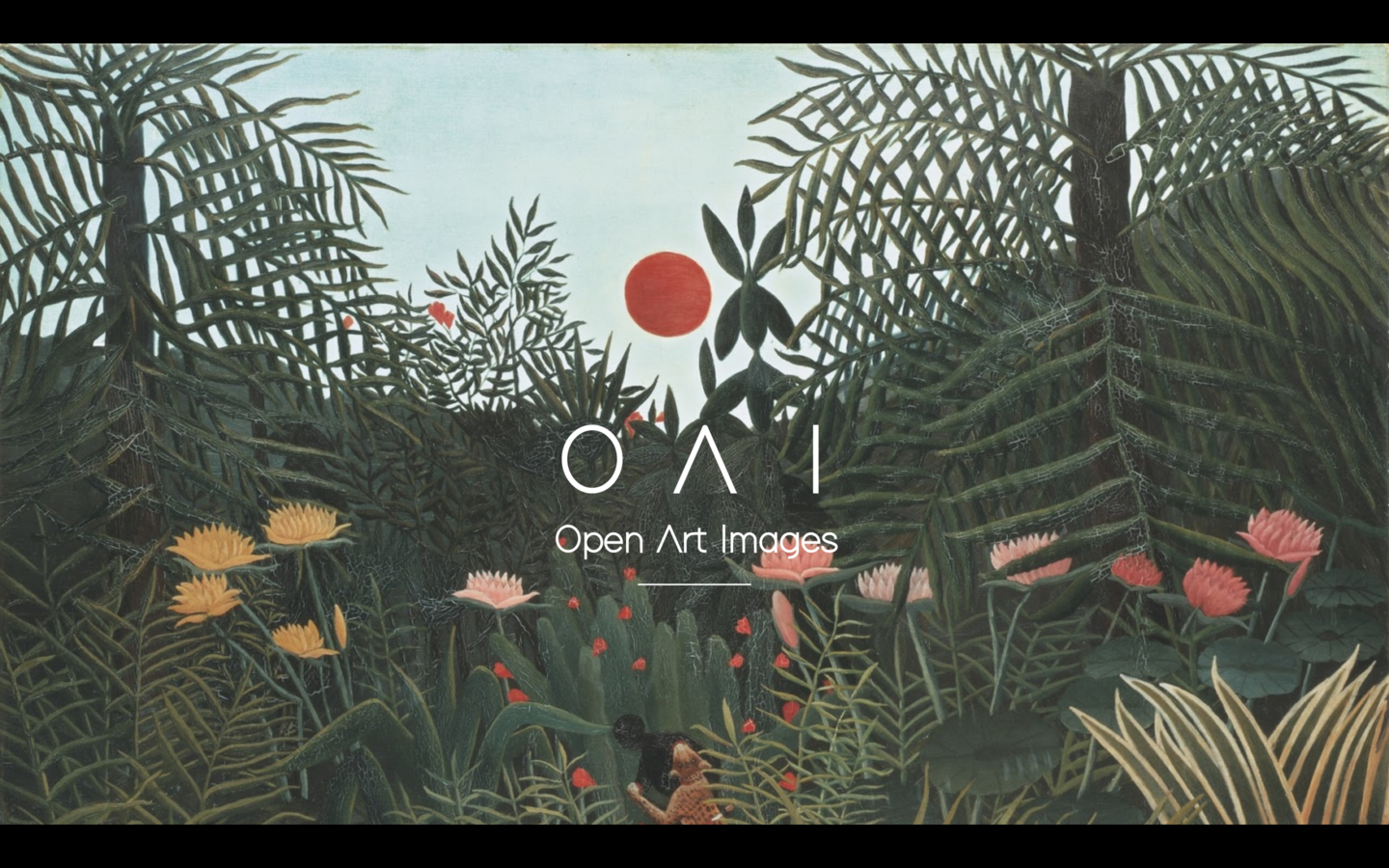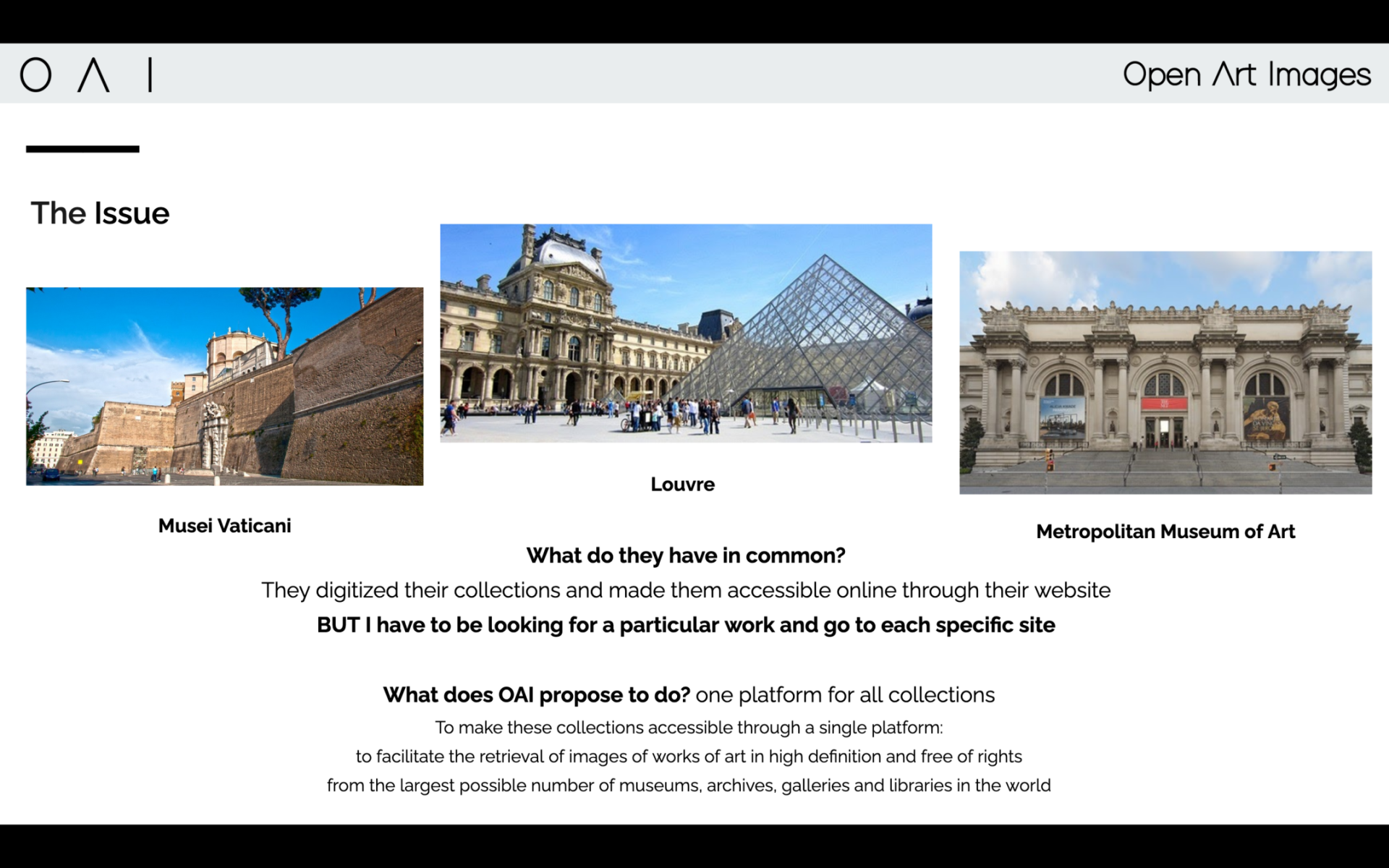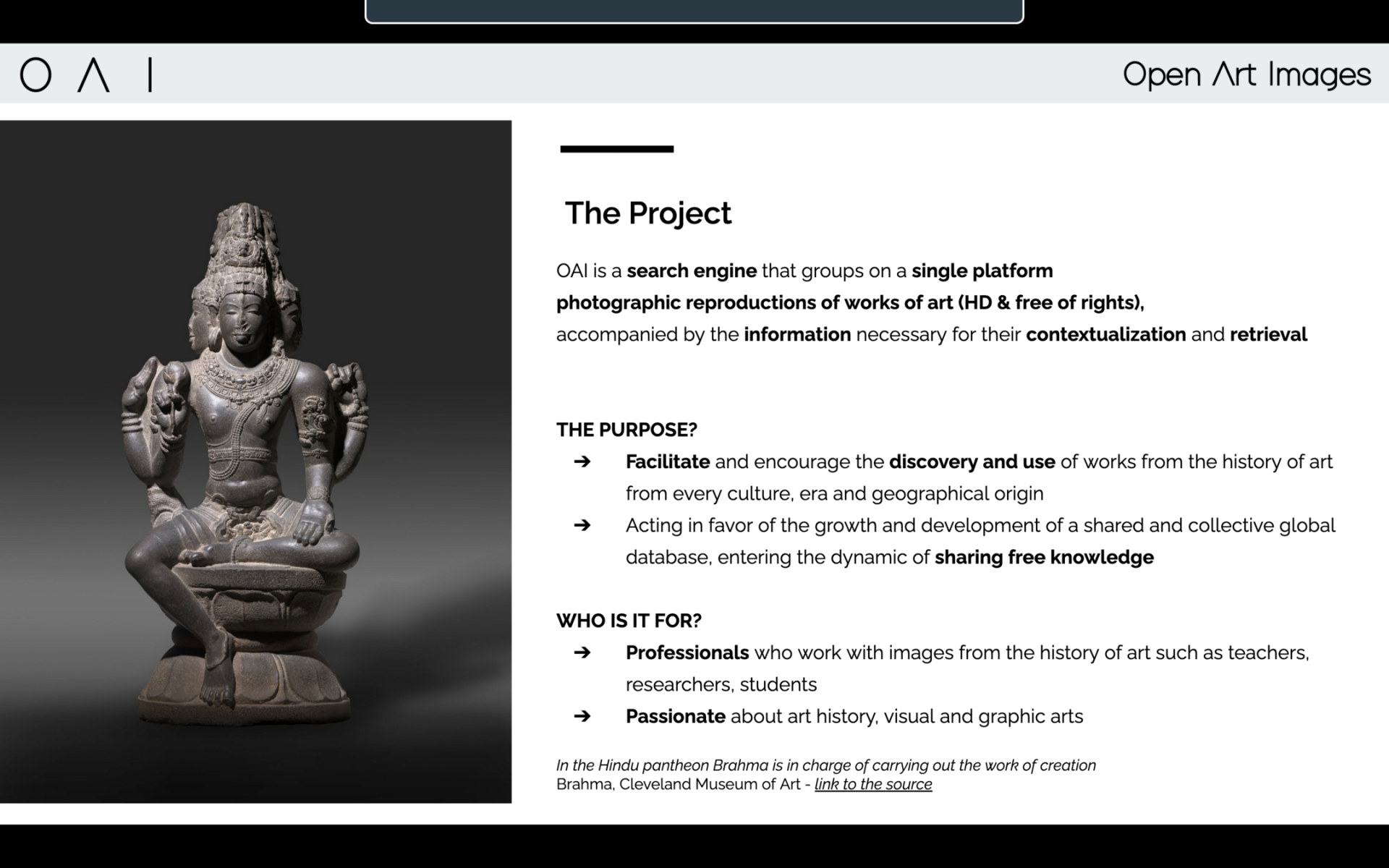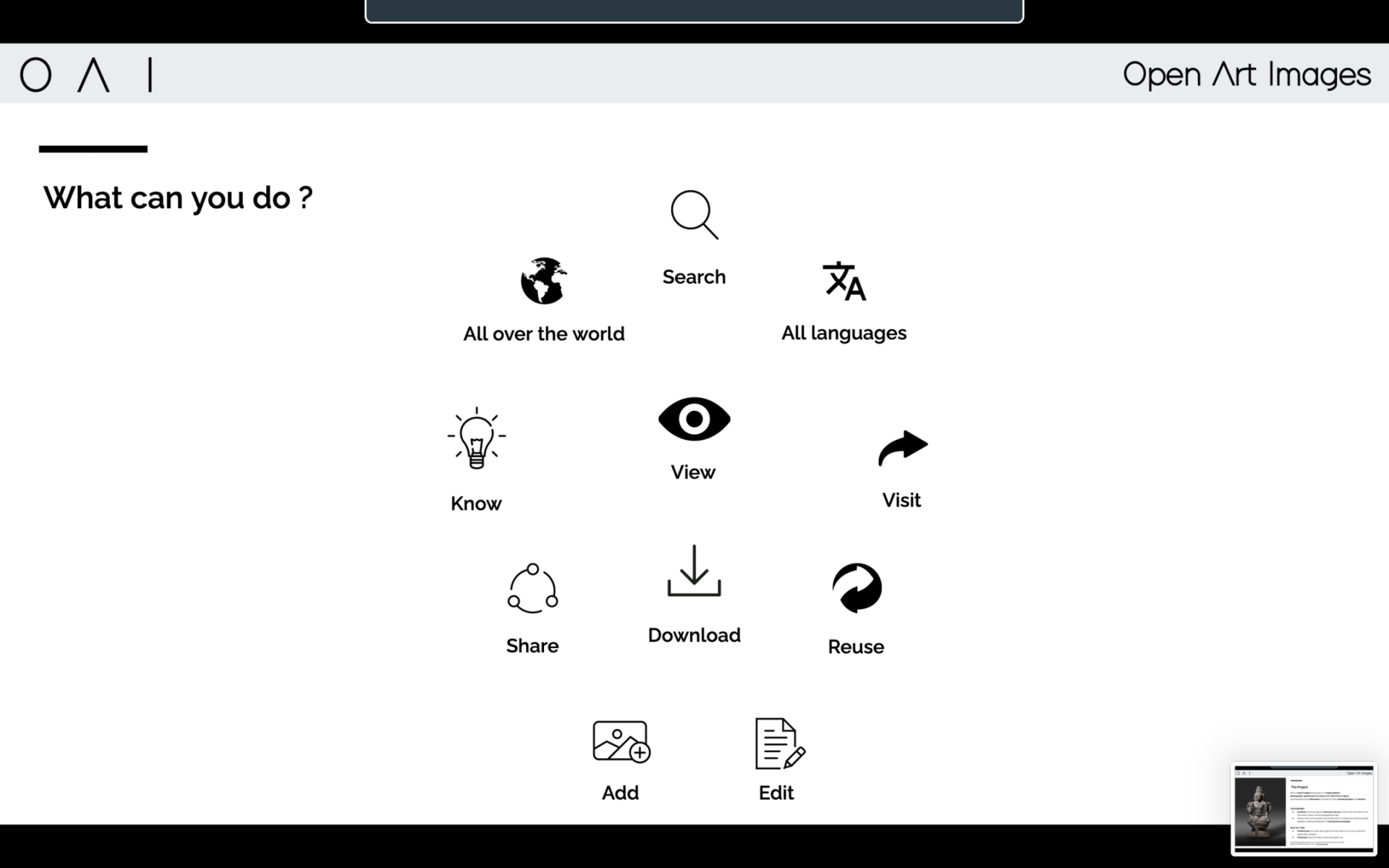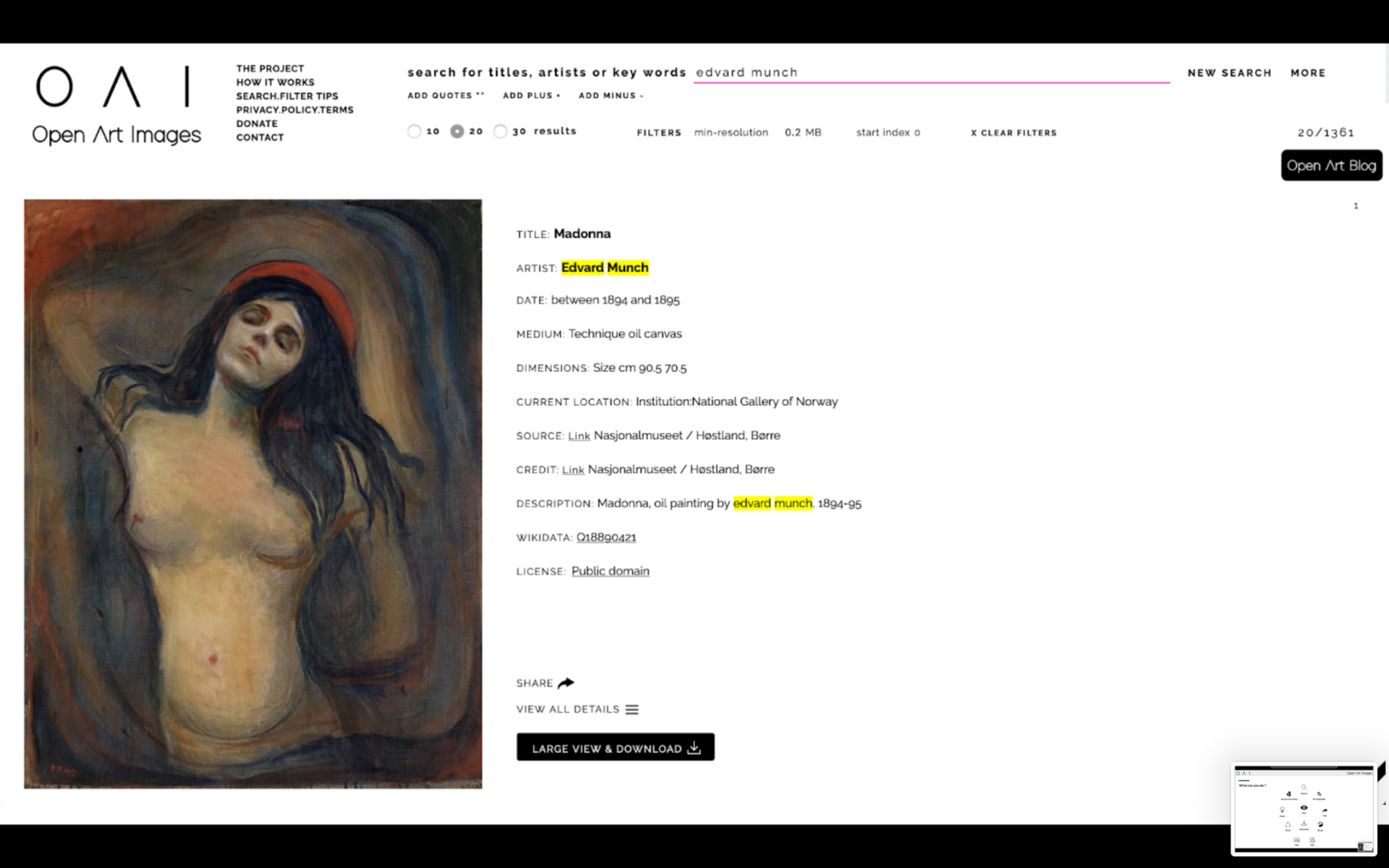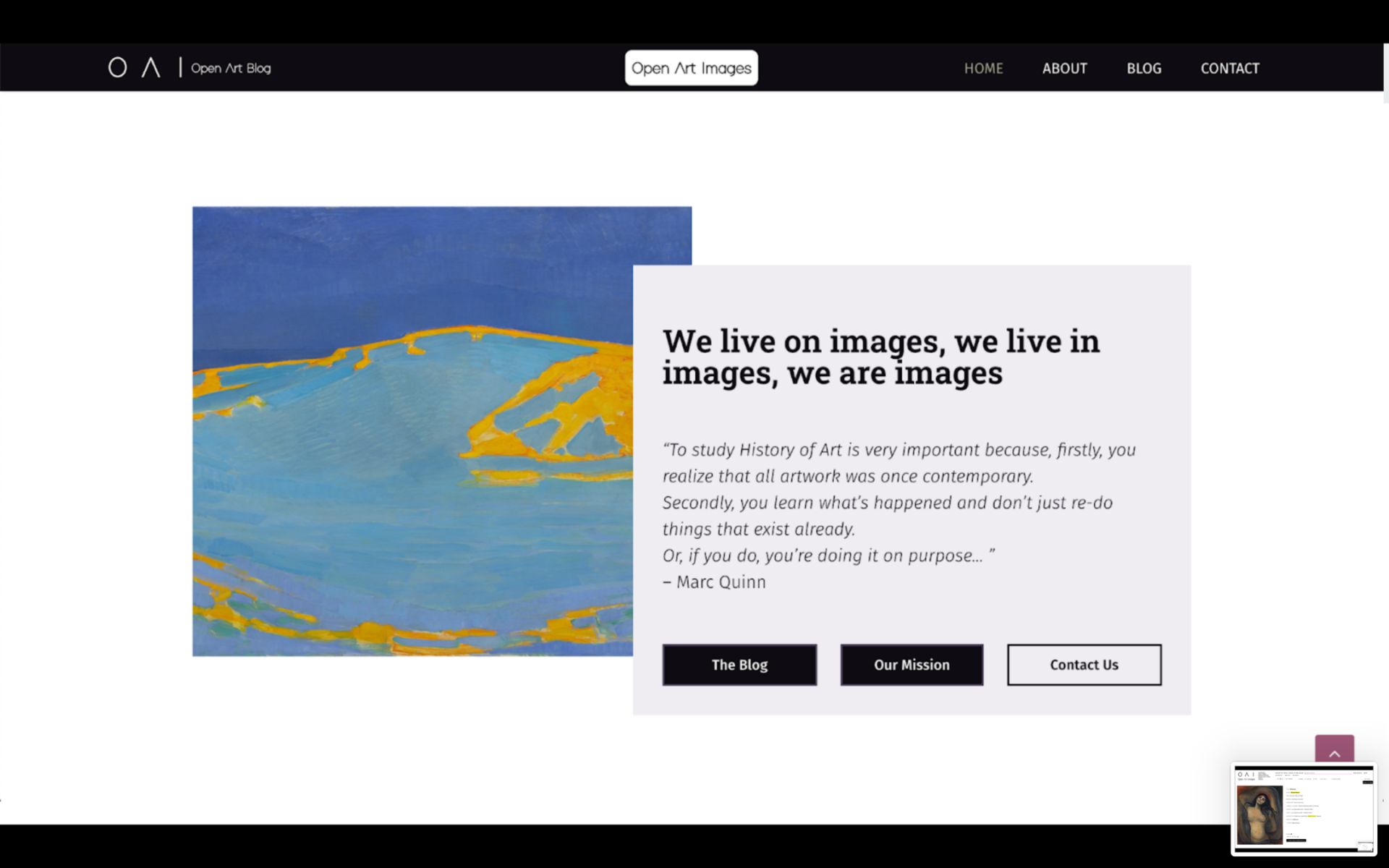Open Art Images
Basic information
Project Title
Full project title
Category
Project Description
Open Art Images is the ‘first free open-access art website’ that allows you to search and download more than 3 million images to use in your professional presentations, research, and communication channels.We care about copyright, this is why we only provide reproductions that are free from legal restrictions.By using Open Art Images you will be attracted by the most beautiful artworks in the world, taking the chance to learn more about them and to embark on a journey around the cultural sector.
Project Region
EU Programme or fund
Description of the project
Summary
Open Art Images (OAI) is a search and visualization engine for high-resolution reproductions of artworks and cultural property that belong to the public domain or their license allows reuse. All images come with detailed metadata, relevant to the understanding of their historical and cultural context and which informs the user about their current location, source, and license. From the homepage(openartimages.com)users can run a research for titles, artists, or key words, or they can navigate the site using the sections organized per different categories, such as Art history timeline, Oriental Art, Themes etc. The homepage has direct access to the Open Art Blog(blog.openartimages.com)that contains articles and insights regarding specific artists, artworks, or museums.
Thanks to the combination of a database containing high-resolution images freely sharable and a forum for the discovery of the art world,OAI aims to contribute to the preservation, enhancement, and democratization of cultural heritage. Its use, in fact, makes art and cultural heritage accessible to anyone and anywhere in the world, making it easier to search and discover new art resources and learn more about them. In doing so, the project also intends to raise awareness among its users regarding the use and sharing of artworks and cultural property reproductions that do not violate any copyright.
OAI was created thanks to the multidisciplinary nature of the team (product designers, project managers, marketing experts, art history editors, developers of artificial intelligence, legal advisors).This is a fundamental aspect of OAI’s success since it allowed a holistic comprehension of the themes addressed and a professional development of the project.Released in its Beta version in March 2020, at the moment Open Art Images provides almost three million images from open and shared databases, collecting digitized works from more than 400 museums, galleries, archives and libraries from all over the world.
Key objectives for sustainability
OAI is a web-app and uses the best standard technology for frontend processing and for dynamic visualization of content. Furthermore, thanks to its technologies, OAI aims to be ecological and this is why it reuses and puts back into circulation resources and data already existing: OAI searches and retrieves data from the web, instead of creating another database or duplicated data and resources.
As a database, OAI uses Linked Open Data retrieved from the Wikimedia Commons database and, in particular, from its visual art fund. We decided to start from the Wikimedia Commons database because it acts as aggregator on the web, gathering other visual arts databases developed by galleries, libraries, archives and museums (GLAMs) of all sizes, by digital communities focused on images (Pinterest, WikiArt, Europeana ...), and by single users. Moreover, the Wikimedia Commons database is open, shared and collective, created and improved continuously by users themselves.
OAI is a scalable software, coded in React.js and using linked data networks: these are technologies that require low maintenance needs and provide great results in terms of user interaction and user experience design, as well as of the size of the exploited database, that grow and develop by itself. As future development, we wish to include more open databases in our searches, in order to assure ever more the scalability and sustainability of OAI’s technologies over the years.
As a team, we use the Agile scrum methodology with 2 weeks sprints set, a project management system that assures a constant and organic growth of the project.
Key objectives for aesthetics and quality
OAI’s motto is We live on images, we live in images, we are images. The role of images and visual communication has dramatically changed over the last decades. If before we could primarily rely on direct sight to enjoy artworks and cultural property, nowadays the proliferation of screens and automated creation has invaded our daily life, so that we could even feel taken hostage by images. One glance is often considered enough to capture an image’s content. Faced with this panorama, we turn to art and to images that have been looked at for decades and centuries; images that were created with the intention of conveying meaning, knowledge and beauty at the same time (docere et delectare). Passed down through history, charged with memory and emotions, today these pieces of art are a priceless heritage, and a resource to be valued. The purpose of Open Art Images is thus to create a shared space, dedicated to these images and common cultural heritage, opening the observer's eyes to images and images to the eye.
We met these objectives through a minimalistic graphic, which puts the spotlight on images, as true protagonists. In this way, we don’t contaminate images with the graphic design that tends to frame images and in some way to disappear. That lets the beauty in images express herself at her best.
Moreover, we designed an easy-to-use user experience, thinked for users of every gender, age and origin.
Key objectives for inclusion
Through its mechanism and its way of working, OAI fosters accessibility and inclusion in many different ways, firstly thanks to the gratuitousness of its service, its design, and its user-friendliness language. All these factors contribute to making cultural heritage as a domain accessible to everyone and in every part of the world.
Other than that, OAI is structured in such a manner that the inclusiveness was not only reached under a ‘functional’ aspect (thanks to its user-friendliness design and the availability of its whole content in English), but also under a ‘cultural’ one. This last goal was pursued by the choice of selecting and incorporating images of artworks and cultural property coming from all different collections and geographic areas, so that each user could feel represented on a cultural level.
To the present day, the inclusiveness of OAI is reflected in the variety of its users: from its release, more than 30k users (growing by 100% each month) from 128 different countries have experimented and used the site since. They are coming from Europe (ca 15.000), but also North America (ca 3.000), Asia (ca 2.000), and from all other countries (ca 1.200); are gender balanced (47% male and 53% female) and belonging to different age ranges (half of OAI’s users is <35 years; the 30% is between 35 and 55 years, and the 20% is>55 years).
As a last remark, it seems relevant to underline how OAI is an art platform structured with the ambition to protect the privacy of its users and their right to participate on the web without being profiled or having their personal data used for other purposes. We strongly believe that this aspect makes Open Art Images an even more inclusive tool that (other than disseminating beauty and creativity) advocates for a transparent web environment.
Results in relation to category
OAI is competing for the Strand A “New European Bauhaus Awards” and, specifically, for its category number 6 titled ‘Preserved and transformed cultural heritage’. As described so far, we strongly believe that its concept, design, and operating mechanism makes it an exemplary model of preservation that enhances access to cultural heritage for all. It is now certain that the digitalization of artworks and cultural property is a way of preservation and enhancement of cultural heritage, and the European Directive 2019/790 of the European Parliament and of the Council of 17 April 2019 on Copyright and Related Rights in the Digital Single Market has confirmed it beyond all doubts.
This Community piece of legislation clearly points out the need and the advantages (from a cultural and educational point of view) of promoting technological platforms and infrastructures that facilitate this combination between digital reproduction and works of visual art, in compliance with copyright prerogative.
OAI succeeded in making available artworks and cultural property belonging to some of the greatest collections of the world, among which we find the MET, the Cleveland Museum of Art, the Rijksmuseum, the Prado Museum, the Louvre Museum, the Getty Center, the Hermitage Museum, and the Tokyo National Museum. Thanks to the digitalisation and reproduction of masterpieces stored in these collections, OAI fosters the access and promotion of culture for all and, by doing this, contributes to the transformation and preservation of cultural heritage.
Finally, it is also possible to state that OAI was able to foresee a behaviour that is now made explicit by many national legislators who are now ready to create ‘digital national libraries’ reproducing cultural property. Under this perspective OAI can be considered a model for similar projects and initiatives that, even more after the experience of the pandemic, seems essential to grant the fruition of culture.
How Citizens benefit
Benefiting citizens in many ways is the principal aim of OAI.
Through the Search - Discovery - Reuse model, we incentivize the reappropriation of the cultural heritage of humankind, making it accessible to all, anytime from everywhere. For this purpose, we use a simple and inclusive language, in the search engine and in the blog, so that the culture can be enjoyed by all. The informal and all levels education is one of the main objectives of our platform.
In addition, we encourage the modification of information and the insertion of new images so that people can feel involved in the cultural creation and are not mere users. In this sense, we invite people of all gender, ages and origin to interact with technology and art in an innovative way.
Moreover, we want to raise awareness on the issues of copyright and legal security on the use of images, encouraging the use of reproductions when there is certainly no infringement of licenses.
Furthermore, OAI aims to promote the passing on of culture between generations through digital tools, in order to involve younger generations and to bring older generations closer to learning through innovative technologies.
Innovative character
Innovation is the basis of the Open Art Images project. Thanks to its search engine, OAI provides the ability to search within the largest digital collection in the world, anytime from everywhere. This tool combined with the blog aims to bring more and more people closer to the study of cultural heritage and to support research and learning in the art sector in an innovative way.
OAI also intends to develop the use of artificial intelligence to support innovative learning of art, developing the possibility of comparing images and carrying out related research with respect to style, technique, medium and the artistic current.
Furthermore, OAI intends to act as a connector between the international public and the events and the exhibitions in progress in art institutions.
A new service is also being developed that will allow users to collect and share their favorite images online, so that cultural heritage will increasingly be part of the transmedial communication, typical of our time.
In the future, OAI intends to develop the blog in an open source manner, giving users the opportunity to be themselves editors of in-depth articles related to the world of art.
In addition, OAI will engage in the use of the blockchain for the certification of the ownership of images, so that the most innovative solutions are adopted in the artistic field.

